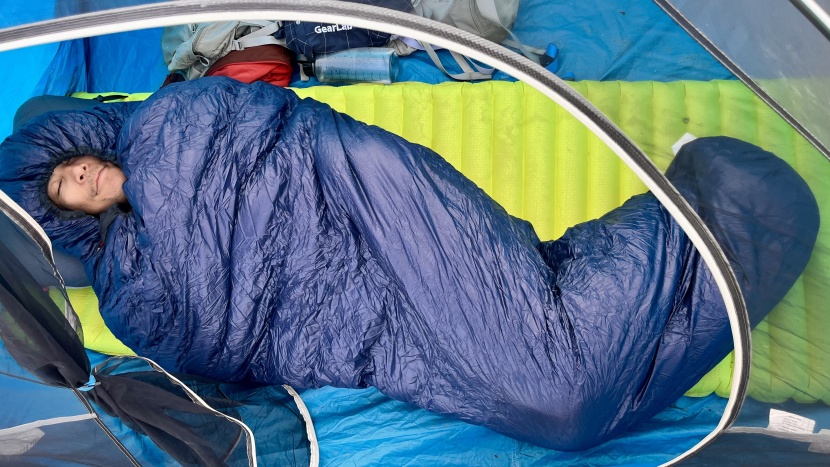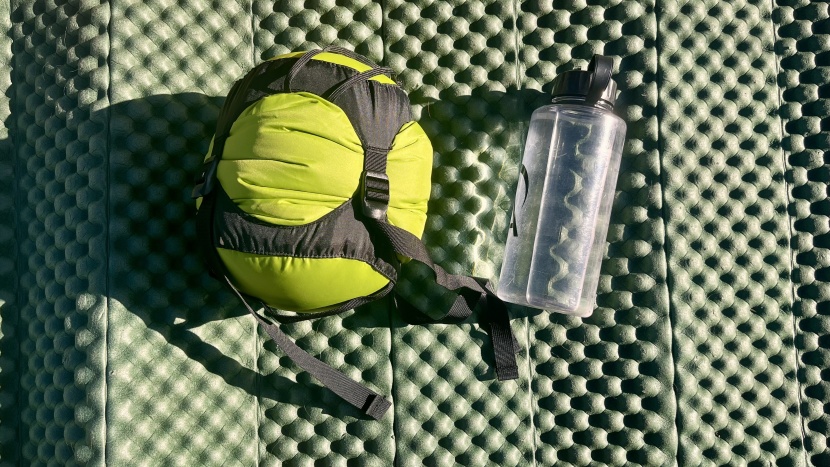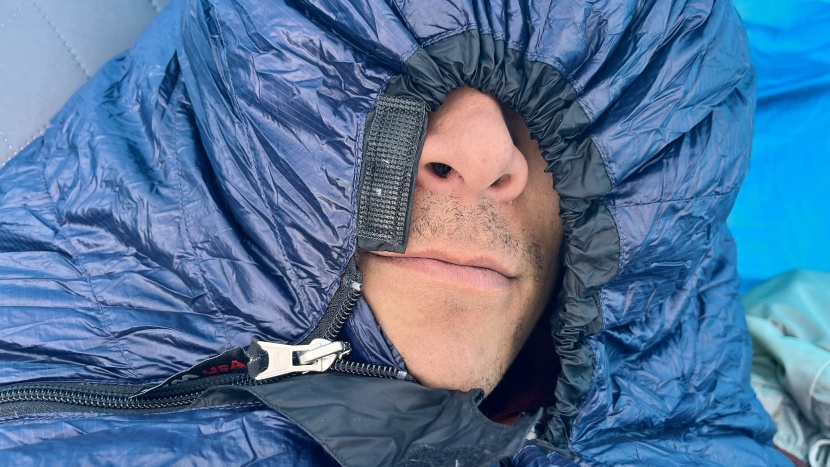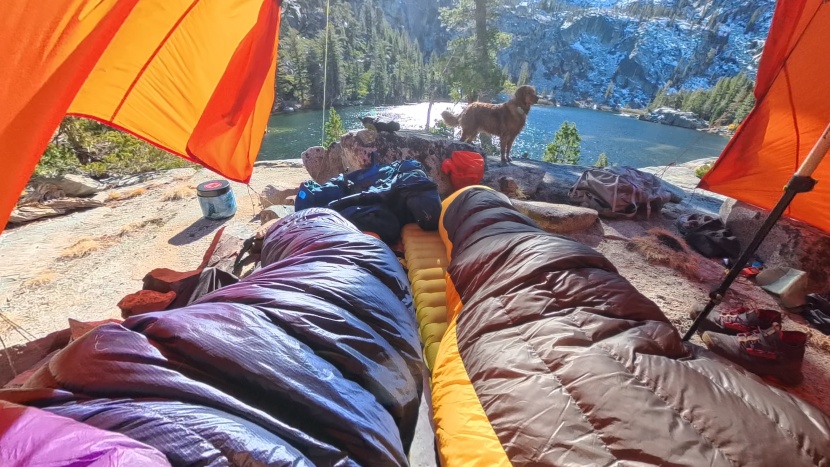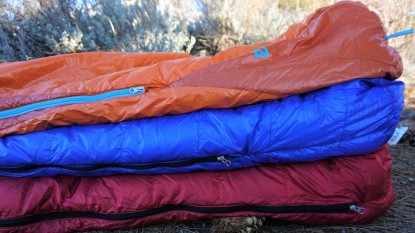
Our Verdict
Our Analysis and Test Results
Even with recent competitive additions to our review, the MegaLite still stands out. It accomplished this with few, if any, changes from its previous versions. Because why fix something that isn't broken? In all seriousness, the MegaLite now faces stiffer competition than ever. Nevertheless, this bag is still one of our favorites for its spacious dimensions, ultra-light weight, and cozy warmth. However, we wish the manufacturer had thought to move the velcro patch further down.
Warmth
In our latest round of field testing, we took this bag for a spin in the late autumn after the first snowfall in the High Sierra. With hammering winds and temperatures below 30 degrees, this bag kept us incredibly warm—almost too warm at some points during the night (though that's easily remedied by simply zipping open the bag). We tested it alongside brand new models with lower temperature ratings, and this model still came out as one of our favorites in terms of sheer warmth.
The MegaLite is filled with down advertised as “850+” fill power. When comparing it with other bags, however, it's important to understand that its fill power is a conservative estimate. Western Mountaineering claims the actual rating of their down is "almost always above 900." They report the lower 850+ number to be on the safe side and indicate the level of loft that's expected once the down is slightly compressed. When we used it, the 13 ounces of down inside this bag felt every bit as lofty as bags with reported fill power over 900, and it's held up over the several years we've owned this bag.
Although Western Mountaineering doesn't publish EN numbers on its website, they are on the foot tag of the sleeping bag. The MegaLite has an EN Comfort rating of 32°F and an EN Lower Limit rating of 21°F. This makes it ideal for pushing the boundaries of “summer.”
This bag is incredibly well insulated and seals in the heat perfectly with its continuous draft tube that keeps out the cold air and seals in body heat. The draw cinches up very small, situated around our nose and mouth, which gave us plenty of space to breathe while keeping the rest of our face warm. The bonus draft collar helped to seal in the heat as well.
Weight
The 6'0" size we tested weighed in at an impressive 1.5 pounds on our scale. This places it close to the front of the pack. When you also factor in its considerable warmth, it results in an impressive warmth-to-weight ratio.
The comfortable, wide dimensions, however, do require additional materials. We've tried a few slimmer primo bags that can achieve similar warmth while weighing a few ounces less. The stuff sack Western Mountaineering includes with the MegaLite is light at 1.6 ounces, but there are other sacks that weigh half as much. We also wish that it had a light compression sack, which would help it pack down smaller. But, you can also buy one separately for not that much extra.
Comfort
What ultimately nudges the MegaLite past its competitors is its comfort. With several extra inches of upper body girth, even our largest testers didn't find this bag constrictive. While we tested the regular 6' version, it's also available in 5'6" and 6'6" lengths, and can be purchased with either a left or right zipper. Even when we slept on our side, we still found plenty of room to roll over inside this sleeping bag. Although this extra space adds a few ounces, the added weight will be worth it for most users, especially when you consider that an ultra-premium down bag can maintain its loft and performance for a long, long time.
Another subtler aspect of MegaLite comfort that distinguishes it from its closest rivals is the shell fabric. All premium bags feature shells that are soft and weather-resistant. However, we've noticed that some can also be strangely noisy, but we didn't experience any troubles sleeping with the ExtremeLite fabric found on the MegaLite.
Packability
In our tests with an aftermarket compression sack, this bag compacted to a respectable packed volume of 6.6 liters. Although this wasn't the smallest size we saw, it is the smallest for bags that provide a similar level of warmth. It was also one of the easiest bags for us to stuff into the compression sack, likely due to the high-quality goose down that compresses easily.
To take advantage of this benefit, however, you will need to purchase a third-party compression sack. The simple drawstring stuff sack that comes with the MegaLite does an okay job at compression but will still leave you with a bag that occupies a couple of extra liters in your backpack. It's also worth mentioning that the included stuff sack is not waterproof. If your travels take you to the rainy Northwest or perhaps paddling in the Boundary Waters, you may want a waterproof storage option.
Features
All of the Western Mountaineering bags, including the MegaLite, feature a flexible internal strip of plastic along the length of their zippers. This strip gives the fabric next to the zipper critical stiffness, preventing it from snagging. The zipper on this bag, compared to anti-snag zippers, was our favorite, not just because it's tough to snag, but also because it lacks resistance and glides effortlessly. The other thing we like about the zipper on this bag is how far down the side of the bag it runs. This lets us open the MegaLite really wide as an improvised quilt for two. It also allowed us to have some targeted ventilation for stinky feet.
Another small issue is the hood. It is anchored at the zipper closure with a weak piece of Velcro that felt awkward to use. When cinched tight, it wasn't the most comfortable, and it sometimes hit us in the eye while we were sleeping. Though if you're not a side sleeper, this may not be as big an issue. However, side sleepers should be wary of this feature.
Should You Buy The Western Mountaineering MegaLite?
If the MegaLite fits within your budget, we highly recommend it—particularly for those who struggle to sleep in cold weather or in the backcountry in general. The benefit of being able to toss and turn at night with no problem, stay warm regardless of the climate, and sleep inside comfortable, durable, breathable, and water-resistant 12D nylon material makes this bag well worth the price. Best of all, it can pack up incredibly small and won't add more than 1.5 pounds to your bag.
What Other Backpacking Sleeping Bags Should You Consider?
Those who like the looks of the Western Mountaineering MegaLite but are more svelte and want to save some weight should consider the Feathered Friends Hummingbird UL 30. It has very similar weight and warmth but a narrower cut that works well for slender hikers.
If you want to spend more time in the backcountry in the late fall or winter, consider the Western Mountaineering UltraLite—it's noticeably warmer, but weighs a few more ounces.
Also worth considering is the Sea to Summit Spark Down 15. This mummy bag has a cinch that's much lower down and didn't impact our sleep. While we didn't feel quite as warm, we would still be psyched to take the Spark on sub-40°F nights and would be perfectly warm. Its light 10D fabric feels like silk sheets, adding a bit of luxury to your adventure. And, it packs up to around the same size as the Mega Lite, and we weighed it to be just a couple of ounces heavier.
| Awards | Best Backpacking Sleeping Bag |
|---|---|
| Price | $580 List Check Price at Backcountry |
Overall Score  |
|
| Star Rating | |
| Bottom Line | The best ultra-premium bag that combines warmth, low weight, good packability, and luxurious comfort |
| Pros | Spacious dimensions, super comfortable, great loft, lightweight, zipper doesn't snag easily |
| Cons | Expensive, awkward hood |
| Rating Categories | Western Mountaineeri... |
| Warmth (25%) | |
| Weight (25%) | |
| Comfort (20%) | |
| Packability (15%) | |
| Features (15%) | |
| Specifications | Western Mountaineeri... |
| Listed Temp Rating (Lower Limit) | 22°F (manufacturer rated) |
| Fill Power | 850+ FP |
| Insulation | Goose down, ethically sourced |
| Measured Weight (Size Regular) | 1.5 lbs |
| Measured Compression/Stuff Sack Weight | 1.0 oz |
| Packed Volume | 6.6 L |
| Listed Fill Weight | 12.0 oz |
| Shell Material | 12D Extremelite 12D nylon |
| Liner Material | 12D nylon taffeta |
| Hydrophobic Down | No |
| Neck Baffle | No |
| Small Organization Pocket | No |
| DWR Treatment | No |
| Zipper Info | Full-length / left or right |
| Listed Shoulder Girth | 64.0 in |
| Listed Hip Girth | 56.0 in |
| Listed Foot Girth | 39.0 in |
| Compression or Stuff Sack | Stuff sack |



